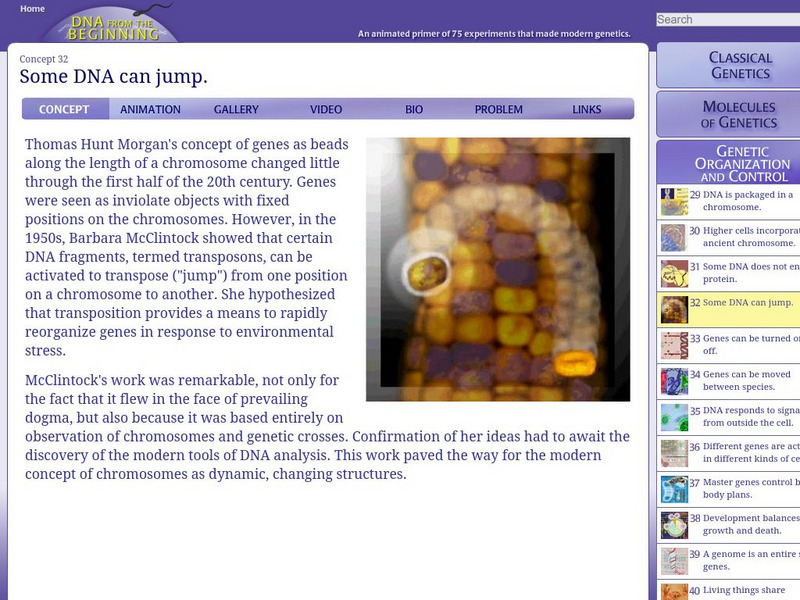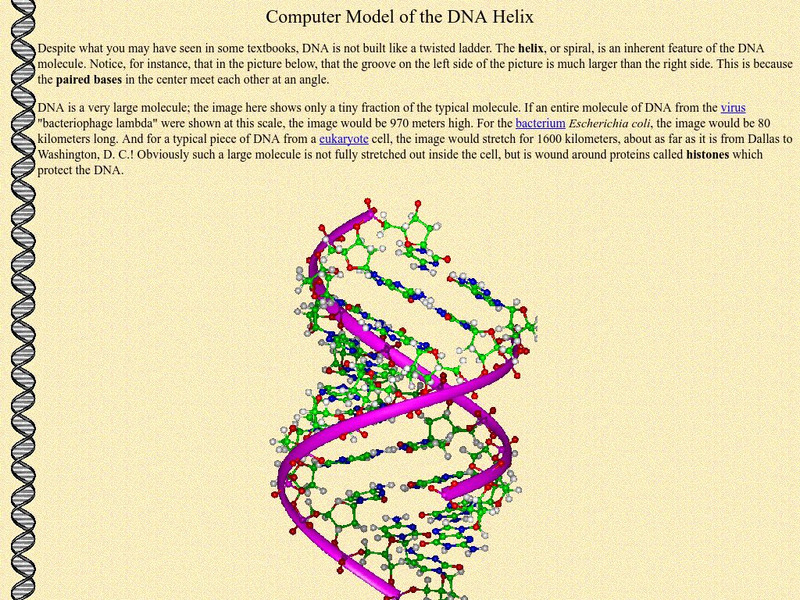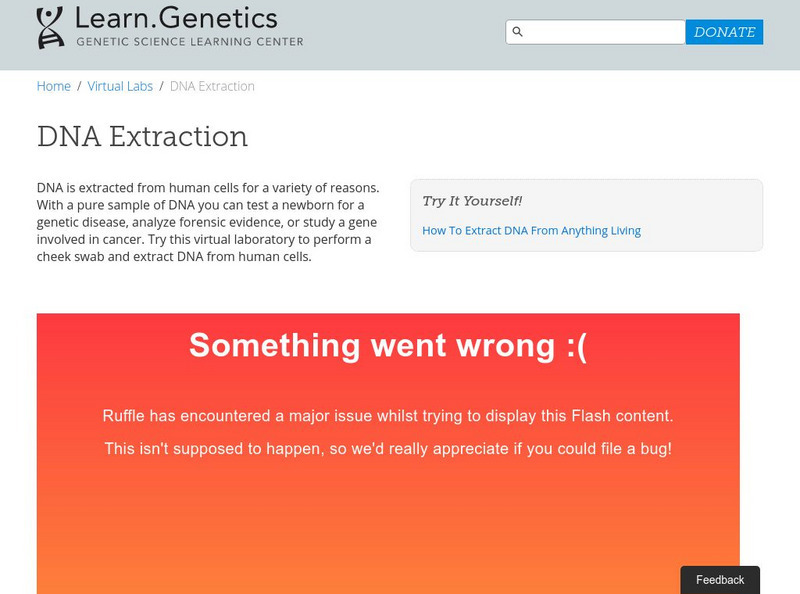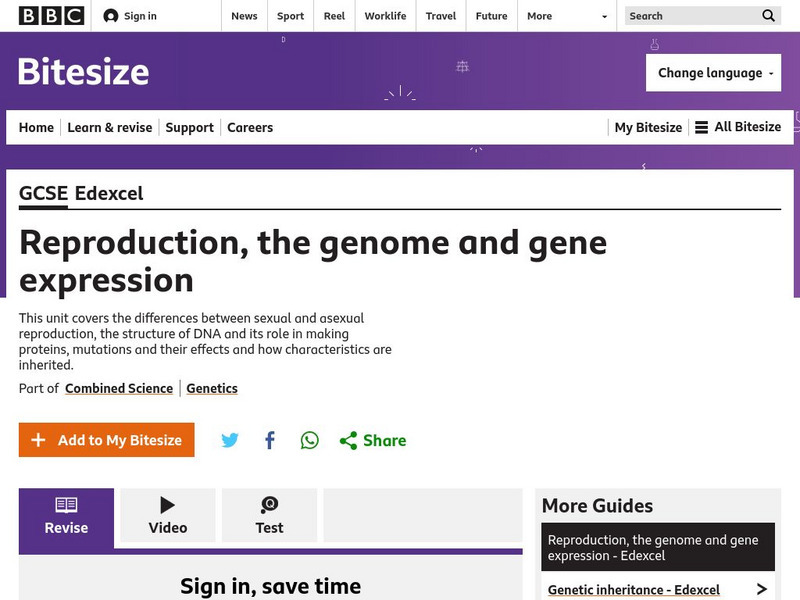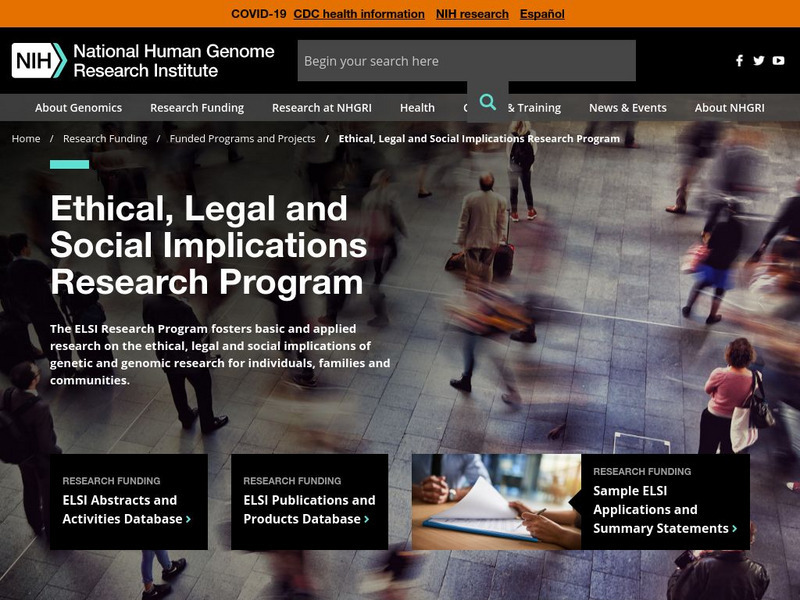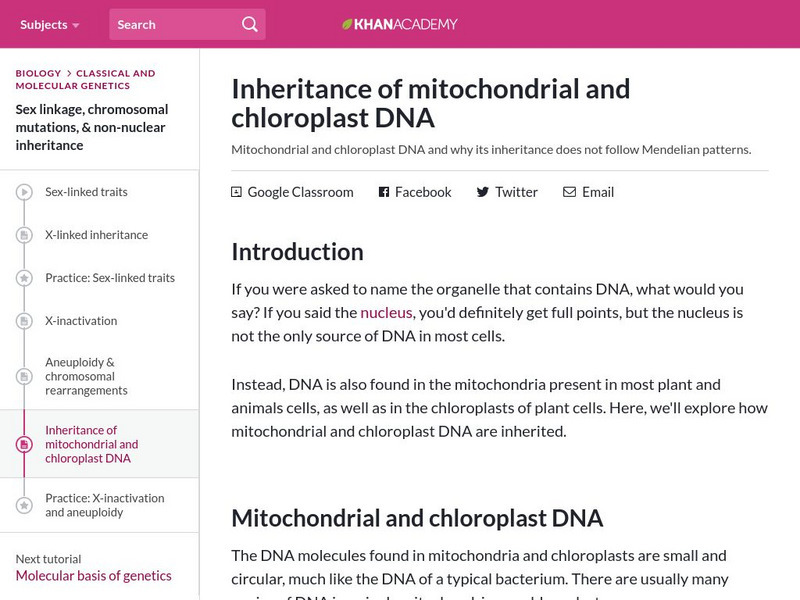Cold Spring Harbor Laboratory
Dna From the Beginning: Some Dna Can Jump
This article contains information on how DNA is repaired to prevent mutated damage from interrupting DNA processes.
Cold Spring Harbor Laboratory
Dna From the Beginning: Dna and Proteins
Explore the convept that DNA and proteins are key molecules of the cell nucleus.
University of California
Ucmp: Computer Model of Dna
A slight departure from the classic view of DNA showing that the molecule is not exactly a twisted ladder. Good image and explanation to go with it.
National Cancer Institute at the National Institutes of Health
National Cancer Institute: What Are Gene Mutations?
This website provides an answer to the following question: "What are Gene Mutations?" Many links are provided throughout this short description that access information on related subjects.
National Health Museum
Access Excellence: Making a Phylogenetic Tree Lesson Plan
Constructing phylogenetic trees may be a daunting task for students, but this lesson plan is a simulation of what molecular biologists must do to determine relationships. This plan is for students who have a good grasp of DNA structure...
Other
I Can Do That: Dna Introduction
In story form, this complete site examines what DNA is, the structure of DNA, genes, and replication. For clarity purposes, the text is supplemented with drawings.
Other
Genome: The Secret of How Life Works
Great site to explore. Offers interactive games and quizzes for students. Includes lesson plans for educators as well. Site is available in Spanish if necessary.
Other
Eureka Science: Genetic Engineering
Explanation of how genetic engineering works. Analogy with molecular scissors cutting a "sentence" of DNA. Has nice animations.
National Health Museum
Access Excellence: Dna Sequencing (Dry Lab Activity)
This site is an advanced level hands-on activity to explain the Di-deoxy sequencing of DNA.
Oak Ridge National Laboratory
Oak Ridge National Laboratory: Dna Forensics
A concise explanation of the use of DNA technologies in forensic identification from the Oak Ridge National Laboratory. Additional valuable resources are provided.
Other
Oregon State University: Barleyworld
This is a site about barley that contains a list on the left with a link to a page about the North American Barley Genome Project.
Nobel Media AB
The Nobel Prize: Dna Rna Protein
Through illustrations and data, viewers will understand either basic or advanced levels of DNA replication, RNA transcription, and protein translation. Click on images to move through this interactive program.
University of Utah
University of Utah: Learn Genetics: How to Extract Dna From Anything Living
Four steps is all it takes to get DNA out of a variety of living things. The requirements include a blender, meat tenderizer, isopropyl alcohol, and a test tube. Sources of DNA include but are not limited to split peas, strawberries,...
National Health Museum
Nhm: Restriction Maps to Cladograms Lesson
This lesson plan requires students to analyze DNA restriction maps to determine the differences in the sequence for several primates and humans. They then use the information to create a cladogram.
Other
Beautiful Chemistry: Beautiful Structures: Dna Nanostructures
DNA is the molecule of life, as life's secrets are encoded in DNA. In this interactive activity. we see the famous double helix structure of DNA.
BBC
Bbc: Gcse Bitesize: Reproduction, the Genome and Gene Expression
This lesson focuses on DNA including it's structure,components,and how it goes together to form genomes. It also provides to links to a video and a test.
BBC
Bbc: Gcse Bitesize: Reproduction, the Genome and Gene Expression
This lesson focuses on how genes, sections of the DNA, are formed including descriptions of transcription and translation. It provides links to a video and a test.
BBC
Bbc: Gcse Bitesize: Cell Division
Chromosomes carry genetic information in a molecule called DNA. A type of cell division called mitosis ensures that when a cell divides each new cell produced has the same genetic information. Links to a video and a test are provided.
Science Struck
Science Struck: Ribose vs. Deoxyribose
Explains what ribose and deoxyribose are, their chemical structure and properties, similarities and differences, their functions, and their biological importance.
National Human Genome Research Institute
Ethical, Legal, and Social Implications Research Program
This is the official division for researching the implications of the Human Genome Project. Find out about topics being discussed involving the ethics of the program, how it is socially accepted, and what sort of legislature is involved...
Khan Academy
Khan Academy: Inheritance of Mitochondrial and Chloroplast Dna
Find out about mitochondrial and chloroplast DNA, and why its inheritance does not follow Mendelian patterns.
BiologyWise
Biology Wise: The Northern Blot vs. Southern Blot Technique
The Northern blot and the Southern blot are two methods used to analyze DNA and RNA. Each technique is described, its purpose, and the methodology. A table comparing features of each is provided.
TED Talks
Ted: Ted Ed: Is Dna the Future of Data Storage?
There is a way that all of human history could be recorded and safely stored beyond the civilization's end. And the key ingredient is inside all of us: our DNA. Leo Bear-McGuinness explains.
TED Talks
Ted: Ted Ed: How Crispr Lets You Edit Dna
Andrea M. Henle examines the science behind gene editing tools such as CRISPR.


